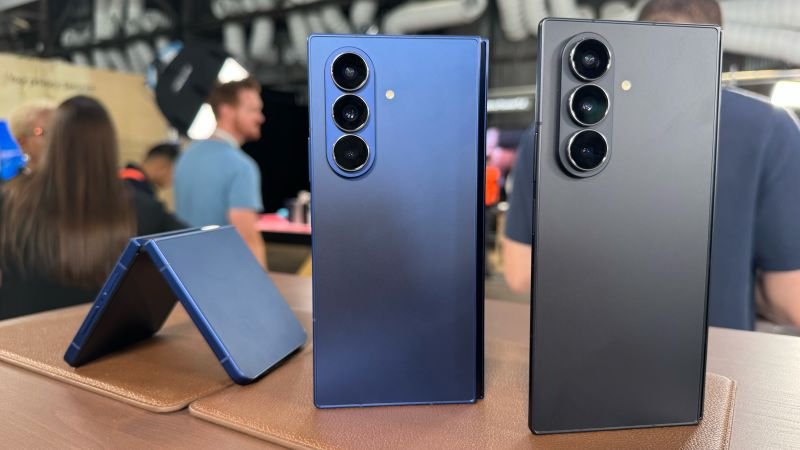Introduction: The Evolution Toward Mainstream Adoption
The world of smartphone technology has always thrived on innovation, from the first touchscreens to the introduction of multiple cameras, and now the push toward foldable displays. For years, folding phones were seen as futuristic concepts showcased at technology expos, drawing attention more for their novelty than for practicality. Early attempts often carried high price tags, limited durability, and software ecosystems that felt unfinished, leading many to dismiss them as luxury gadgets for enthusiasts rather than mainstream devices. However, recent years have brought significant improvements in design, functionality, and affordability, creating a real possibility that foldables could finally achieve mass adoption. Understanding why folding phones may soon cross this threshold requires looking at how the technology has matured, how consumer expectations have shifted, and what industry trends point to broader market acceptance.
The Journey of Foldable Smartphones So Far
Foldable smartphones first captured global attention when Samsung introduced the Galaxy Fold in 2019. While it marked an ambitious leap in mobile design, the launch was marred by durability issues, including fragile screens and hinges that struggled under real-world conditions. Similar struggles plagued other manufacturers experimenting with the concept. Yet, despite these setbacks, the foldable phone market grew steadily, signaling strong consumer curiosity and demand.
- Over time, brands like Huawei, Motorola, Oppo, and Google joined the race, each introducing their own foldable designs, ranging from clamshell-style compact phones to tablet-sized foldables that unfold into larger displays.
- This competition accelerated innovation, pushing companies to improve hinge mechanisms, develop ultra-thin glass, enhance durability, and optimize mobile operating systems for foldable interfaces.
- Today, foldables are far more reliable, sleeker, and practical than their predecessors, making them more appealing to mainstream consumers who previously hesitated.
Why Folding Phones Are Becoming Attractive
Several factors now position foldable devices for wider adoption. Unlike the early years, when compromises overshadowed benefits, the modern generation of foldables offers tangible advantages that align with how people actually use their devices.
- Bigger Screens in Smaller Bodies: Consumers crave immersive displays for gaming, streaming, and multitasking, but don’t want to carry bulky tablets. Foldables solve this dilemma.
- Improved Durability: Advances in hinge technology and ultra-thin glass screens now provide resilience against wear and tear.
- More Affordable Options: Once costing over $2,000, foldables are now available in the $800–$1,200 range, putting them closer to premium smartphone territory.
- Optimized Software Ecosystems: Android and app developers now design interfaces that adapt seamlessly to folding and unfolding, enhancing usability.
- Unique Style Factor: Beyond functionality, foldables carry an undeniable cool factor, which appeals strongly to younger consumers and early adopters.
These changes collectively bridge the gap between novelty and practicality, positioning foldable phones not just as futuristic toys but as realistic daily drivers.
Price Drops and Market Competition
One of the biggest barriers to adoption has been price. Early models often exceeded $2,000, making them inaccessible to most consumers. However, increased competition and advancements in manufacturing efficiency have steadily driven costs down. Samsung, for instance, has introduced foldables under $1,000, while other brands are following suit.
To illustrate this trend, consider the table below:
| Year | Average Price of Foldables | Market Perception |
| 2019 | $2,000+ | Luxury, niche product |
| 2021 | $1,200–$1,500 | Premium alternative |
| 2023 | $999–$1,300 | Competitive flagship option |
| 2025 (projected) | $700–$1,000 | Mid-range availability |
As prices fall, more consumers will view foldables as competitive with traditional smartphones rather than expensive experiments.
Software Optimization for Foldable Experiences
Another critical factor in mainstream acceptance is the ecosystem of apps and operating systems. In the early days, most applications struggled to adapt when screens transitioned from folded to unfolded, often displaying awkward layouts or wasting screen real estate. Today, both Google and Samsung have worked closely with developers to create apps that fluidly scale across different orientations.
For instance, split-screen multitasking has become far more intuitive, allowing users to browse the web on one side of the display while taking notes or streaming video on the other. Productivity tools like Microsoft Office and Google Workspace now integrate foldable-friendly features, while entertainment platforms like Netflix and YouTube optimize video playback for different screen states. This growing software maturity enhances usability and makes foldables more practical for work, creativity, and entertainment.
Improved Durability and Design Engineering
Durability has always been the Achilles heel of foldable smartphones. The hinges in earlier models often failed after a few months, and the soft plastic screens scratched easily. Recent engineering breakthroughs, however, have significantly improved long-term performance.
- Manufacturers now employ ultra-thin glass technology layered with protective coatings, allowing foldable displays to withstand repeated folding while maintaining touch sensitivity.
- Hinges have become more robust, often tested to survive 200,000 folds—equivalent to folding and unfolding a phone 100 times a day for five years.
- Moreover, water resistance, once thought impossible for foldables, has started appearing in newer devices.
- These durability improvements help reassure mainstream buyers who prioritize reliability.
Consumer Lifestyle Shifts Favor Foldables
Modern consumers rely on smartphones for everything from entertainment and productivity to health tracking and photography. The ability to have a compact device that transforms into a mini-tablet aligns perfectly with these lifestyle needs. Students can use foldables for note-taking and studying, professionals can multitask on the go, and families can enjoy portable streaming without needing multiple devices.
Additionally, the rise of remote work and mobile-first lifestyles makes foldables especially attractive. Users who once carried both a phone and a tablet may now see foldables as a single, all-in-one solution. This practical value proposition may ultimately drive mainstream acceptance more than aesthetics alone.
Market Growth and Forecasts
Industry analysts predict that foldables could represent a significant portion of smartphone sales within the next five years. According to IDC and Counterpoint Research, foldable shipments grew from just 1 million units in 2019 to nearly 20 million in 2023. Projections suggest this number could exceed 50 million units annually by 2027.
Here’s a breakdown of foldable phone shipment growth:
| Year | Global Shipments | Market Share of Smartphones |
| 2019 | 1 million | <0.1% |
| 2021 | 7 million | 0.5% |
| 2023 | 19 million | 1.4% |
| 2027 (projected) | 52 million | 4–5% |
Though still a small percentage of the overall smartphone market, the trajectory is unmistakable. As prices drop, designs improve, and software matures, foldables will become a legitimate competitor to traditional smartphones.
Challenges That Still Remain
Despite their progress, foldables are not without challenges. Battery life often suffers due to powering larger displays, and foldable designs remain thicker and heavier than slab-style smartphones. Repairs can be costly, as specialized parts like hinges and flexible displays are expensive to replace. Finally, consumer skepticism still lingers, particularly among those burned by the durability issues of early models.
For foldables to fully go mainstream, manufacturers must continue addressing these challenges while ensuring that prices remain competitive with high-end flagship phones.
The Role of Branding and Marketing
Marketing plays an enormous role in shaping consumer perceptions. Samsung’s “Galaxy Z” branding and consistent advertising campaigns have normalized foldables in the public eye, presenting them not as experimental gadgets but as polished, aspirational products. Other manufacturers, including Motorola with its revived Razr line, rely heavily on nostalgia to build excitement. These strategies highlight how storytelling, lifestyle marketing, and influencer promotion are helping foldables become desirable for wider audiences.
How Foldables Compare to Traditional Flagships
While foldables are improving, how do they compare with the best slab-style smartphones?
| Feature | Foldable Phones | Traditional Flagship Phones |
| Screen Size | Larger, expandable displays | Fixed, smaller screens |
| Portability | Compact when folded | Slimmer and lighter |
| Durability | Improving, but complex hinges | More robust overall |
| Price | Higher, though dropping | Broader range, more affordable options |
| Software | Optimized for multitasking | More consistent and established |
This comparison shows that foldables are competitive in many areas but still face trade-offs. For mainstream success, their advantages must outweigh their drawbacks for average consumers.
Looking Ahead: The Next Phase of Foldables
The next stage of foldable innovation may involve rollables, devices that expand by unrolling flexible displays rather than folding. Concepts from LG, Oppo, and TCL have already teased these possibilities. Additionally, advancements in battery efficiency, lighter materials, and AI-powered foldable experiences could further redefine how these devices integrate into everyday life.
If manufacturers can successfully combine lower prices, enhanced durability, and practical features, folding phones may not just be mainstream—they could become the default choice for premium smartphones within the decade.
Conclusion: Foldables on the Verge of Mainstream
The path of foldable smartphones has been one of trial, error, and persistence. Early adopters paved the way, but now the combination of lower prices, better durability, mature software, and shifting lifestyles makes foldables appealing to everyday users. While challenges remain, the trajectory is clear: folding phones are no longer a futuristic dream but a practical, stylish, and versatile reality. If industry trends hold, the next generation of smartphones may be defined not by how powerful they are, but by how seamlessly they fold and adapt to our lives.
FAQs About Folding Phones
1. Are folding phones more fragile than regular smartphones?
Modern foldables are much more durable than early models, with ultra-thin glass and hinges tested for hundreds of thousands of folds, but they still require slightly more care than traditional smartphones.
2. Do foldable phones have shorter battery life?
Larger screens consume more power, which can reduce battery life compared to slab-style phones. However, most foldables now include large batteries and fast charging to balance this issue.
3. Will foldable phones replace tablets?
For many users, yes. Foldables can serve as both a smartphone and a small tablet, reducing the need for two separate devices.
4. Are foldable phones water resistant?
Some newer models, like Samsung’s Galaxy Z Fold and Flip series, offer water resistance, but not all foldables currently have this feature.
5. Why are foldable phones still expensive?
Specialized displays, hinges, and materials make manufacturing more costly. Prices are falling, but they remain higher than many traditional smartphones.
6. Which brands currently sell foldable phones?
Samsung, Huawei, Motorola, Oppo, Honor, and Google all sell foldables, with more brands expected to join in the coming years.
7. Do apps work well on foldable phones?
Most major apps now support foldable layouts, and Android has optimized multitasking for these devices. However, some smaller apps may still struggle with scaling.
8. How long does a foldable phone last?
Most are rated for around 200,000 folds, which equates to several years of daily use under normal conditions.
9. Can foldable phones be repaired easily?
Repairs are generally more expensive and complex due to specialized parts. Warranties and insurance are often recommended for foldable owners.
10. Will foldable phones become mainstream in the next five years?
Yes, analysts project significant growth, with foldables capturing around 5% of the smartphone market by 2027, putting them firmly in the mainstream category.


